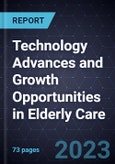Predictive Health Monitoring and Intelligent Assistance Drive the Industry’s Innovation Culture
World Health Organization statistics state that by 2030, one out of six people will be 60 years of age or more. The aged population will likely increase from 1 billion in 2020 to 1.4 billion in 2030 and 2.1 billion by 2050. The senior population typically experiences a gradual decrease in physical and mental capacity. This causes a high disease and socioeconomic burden on patients and the healthcare system. There is a need for innovative solutions to promote active and independent aging for older people.
In this report, the author profiles innovations in remote health monitoring and health assistive technologies such as wearables and contactless monitoring, virtual or robotic health assistant, and smart pill dispensers. The analysis shows the integration of digital technologies, such as artificial intelligence and machine learning, and the internet of things-enabled solutions to make monitoring and assistance intelligent and proactive.
The report also covers innovations around each technology segment, enabling technologies, industry initiatives and trends, and patent analysis.
Other vital information includes:
- Drivers and restraints for the industry and technologies
- Research efforts in the elderly care space, particularly in health monitoring and assistive technologies
- Notable players leading industry trends
- Acquisitions, partnerships, funding, and new business models for the elder care space
Most importantly for stakeholders, the report offers several growth opportunities in elderly care innovations they can explore and capture over the next few years.








